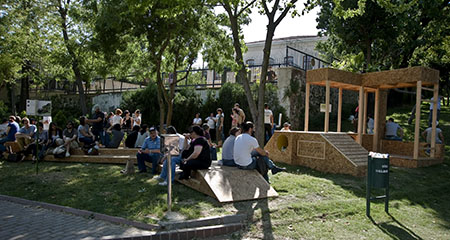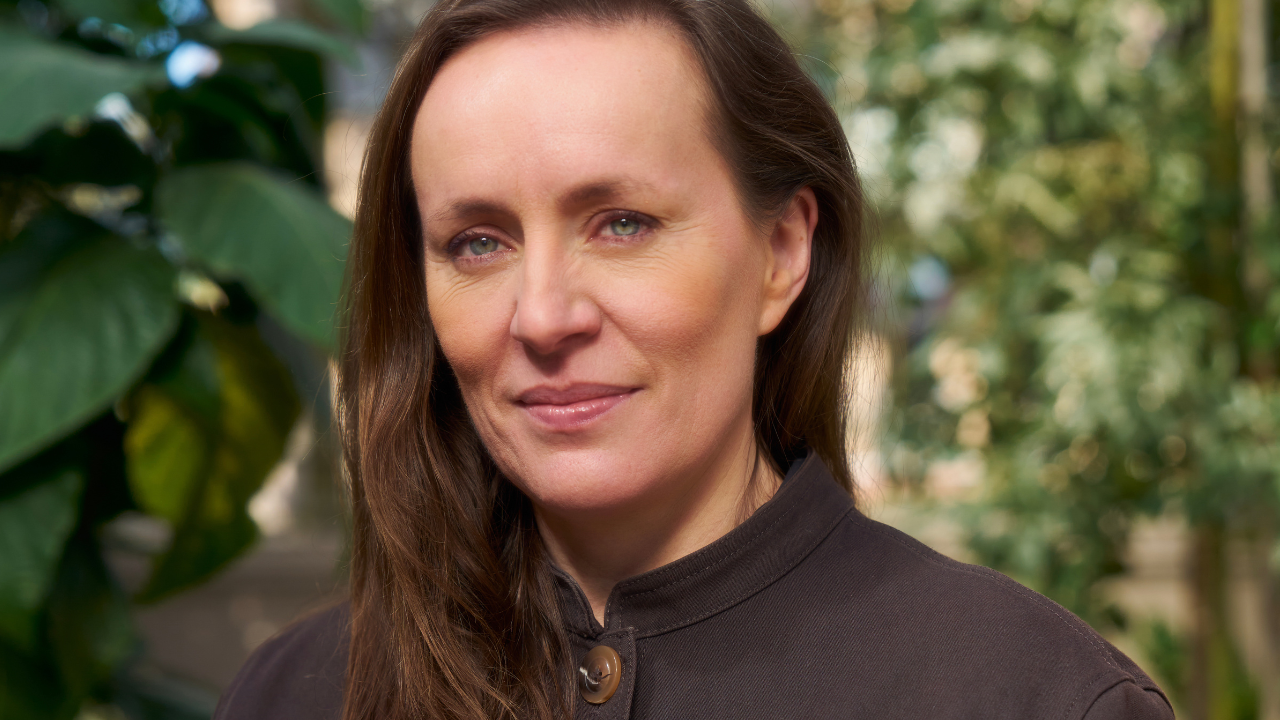Social Spaces
Dan Graham discusses sci-fi, dance, model-making and the ‘just-past’ with Turkish artist Can Altay
Dan Graham discusses sci-fi, dance, model-making and the ‘just-past’ with Turkish artist Can Altay

CAN ALTAY My first real appreciation of your work was in Berlin several years ago, when I came across Elliptical Pavilion (1995) on the Spree river.
DAN GRAHAM I first got the idea for that work when I was walking along the Spree: the elliptical form of the pavilion would be reflected in the water next to the reflections of three new elliptical buildings on the other bank. But Kasper König, who had commissioned me, said no to the proposal, because he wanted Per Kirkeby to make a work on that particular site. Instead we made an artificial pond, but it didn’t work as well; in the end, the water had to be drained because people were pissing in it.
CA When I went into that pavilion I was really amazed to see what I’d been missing – that crucial aspect of ‘being inside’ your work.
DG Early on, my gallery (John Daniels Gallery, New York, which Graham opened in 1964) showed artists like Sol LeWitt, Dan Flavin and Don Judd, but at a certain point I came out of Minimal art. In Minimal art there is no inter-subjectivity, and my work came to be based on it. For example, my work is also about how corporate buildings use two-way mirrored glass in a one-way mirror situation. Two-way mirror-glass cuts down the air conditioning costs because the reflective side deflects the sun’s heat, but it also reflects the sky and so identifies the corporation with the natural environment.

CA It’s also a shift from the Modernist ideal of transparency to a kind of corporate ideal of surveillance.
DG Yes, though the Modernist building’s transparency – which claimed to show the transparency of the corporation’s operations – was an alibi. The view of the people working on the ground floor was only of lower-level functionaries; on the upper floors, people who had the power could look down, unobserved, at the surrounding cityscape, which the corporation dominates.
CA Your work requests a kind of ‘dwelling in’, rather than a ‘gazing upon’ – viewers have to go inside to fully appreciate the alternating perception.
DG It’s always at human scale. While I’m not necessarily a humanist, I think that your body is so important. Minimal art was about instantaneous present time – that was the 1960s idea. But I was more interested in the sun setting, clouds changing, as people moved their bodies in time. So that became a critique of Minimal art; time became important. Of course, that was a little influenced by marijuana, but also by LaMonte Young’s and Steve Reich’s music and the idea of process or duration – Minimal art was not durational.
CA Late modern architecture, and the birth and growth of corporate culture, coincided with a very particular mode of urbanization and sense of public spaces. Since the late 1990s, when I first started showing my work in Istanbul, the city has been getting a new skyline, especially on a large strip called the Büyükdere Axis. They’ve been building high-rise office blocks, which have generated a so-called plaza culture, but the plazas here are badge-access corporate high-rises. The buildings always come first in Istanbul; infrastructure is more like ‘inter-structure’ – life has to fill in the gaps. Your work relates to the city both as the immediate context for the actual work and as a reference material.

DG My experience in seeing New York’s shopping streets was very important to me. When I was 14, I read Jean-Paul Sartre’s Being and Nothingness (1943) and I think my interest in the inter-subjective gaze comes from his idea of the child’s ‘mirror stage’ in terms of cities. Showcase windows use ‘mirror stage’ optics: when you’re looking at a display you see both the products and – on fragmented mirrors – distorted images of yourself as an un-whole body. A ghost image of yourself is displayed, superimposed on the product; if you buy the product then you can become whole again.
CA That sounds very much like the inter-subjectivity you were examining in the early video works.
DG Walter Benjamin’s idea of the ‘just-past’ has been important to me. In other words, you don’t have just the present time or neo-1960s, but an extended present time that is a continuation of the ‘just-past’.
CA In 2005, I did a piece at Platform Garanti in Istanbul that was very much related to this idea. Over the course of several exhibitions, I reconfigured and combined all the exhibited works in one gallery. So the new show would open but the old shows would still linger in the corner, growing and growing. I was working with extracts and samples from the works by artists who were shown as listed in the title of the piece, along with documentation of the ways in which the artists themselves installed them. But it was obviously becoming something else; both the exhibition and the exhibited were being reconfigured.
DG A piece that you might not know I did was in an alternative space called the Franklin Furnace in SoHo. In the shopfront, I projected slides of the entire exhibition space taken from the front window view of every gallery exhibition concurrent with my show (1979). At the time I was very inspired by drug-influenced science-fiction writers such as Brian Aldiss, as well as by Gregory Bateson’s writing, especially his ‘double-blind’ theory of schizophrenia. Bateson was married to Margaret Mead, whose books on matriarchal societies in primitive culture I read when I was only 13, which is why I became a feminist. All of my undocumented early video pieces were about learning processes and public access television. But I have one critique about my work: it’s very male voyeuristic. And I’m a feminist, so I’m a little embarrassed about that.
CA Another thing about the video-based installations is that they somehow remind the viewer that they are part of a group. The audience always forms a group, a contingent community.

DG In the early 1960s, a great influence on me was Anna Halprin’s dance group in San Francisco, which was something like a psychologically therapeutic body workshop. The participants included Reich, Simone Forti, Robert Morris, Bruce Nauman and Yvonne Rainer. The Halprin group was interested in the physical aspects of body movement but also in the dancers’ interactions in communal, social situations. Her workshop came out of a kind of early, hippie communal, psychological mind set. Its influence came to New York through the transplanted San Franciscans, Reich and Richard Serra, both of whom I met shortly after they arrived in the early ’70s. When I first met Richard, he told me that Simone’s work was a big influence on his sculpture, especially her use of gravity in human movement.
CA I’m interested in how function clashes and/or overlaps with meaning. I deal with this question a lot in my work, increasingly so in projects such as park: bir ihtimal (park: A Possibility, 2010), which involved installing the work of artists – including Nils Norman and Ceren Oykut – alongside collectively produced elements in a park in Istanbul. Similarly, my 2011 exhibition at Casco in Utrecht was an investigation into the city’s public sculptures, which resulted in a set of proposals for prosthetic additions to existing monuments and sculptures. In these projects, I usually go for semi-functional or slightly dysfunctional programming and settings, to push those overlays and to make room for glitches and discrepancies.
DG When I had my gallery, my first artist was LeWitt and my hero was Flavin. They both worked as guards in ‘The Great Experiment: Russian Art, 1863–1922’ show (Museum of Modern Art, New York, 1962), and my work really comes out of the kind of quasi-functionality, quasi-design of Constructivism. But I also like things that are not one thing or the other. Hybridity is a very important feature in my most recent works, which function as a bridge between art and architecture.

CA You often work with models in different senses, and even show them as sculptures. I see model-making as a dual process: one side involves producing models that can be applied or realized on a larger scale; the other is to do with building scale replicas in manageable and relatively controllable forms, which requires the extreme attention found only in enthusiasts and hobbyists. This dual process fascinates me because both sides involve an intensity of imagination, though each faces in a completely opposite direction.
DG The first models I did were for my show at Oxford’s Museum of Modern Art in 1978. I’d seen an exhibition Leo Castelli did of architectural models displayed as gallery art, and I thought: why shouldn’t artists do models by architects which could also be propaganda for projects that could actually be realized as well as be art objects? For that show I made two kinds of models: one group were fantasies for suburban situations like Alteration to a Suburban House (1978); the others were proposals for ‘sculpture/pavilions’ to be someday realized. The first time I made very cheap models, which I’d take in a suitcase and use to convince clients. For those first models, I would go to hobby shops and so on.
CA In recent exhibitions you’ve shown model pavilions alongside videos of actual pavilions. Is that a new way of making work over the pavilions, in a sense that builds a narrative of the experience of the pavilion through more human-scale representation?
DG Nicholas Logsdail, my Lisson dealer, suggested I should make models of my pavilions which could function as saleable sculptures. I did this, but in fact my work is not exactly sculpture; the models don’t really replicate the situation of my work. My work is very site-specific – it’s about light conditions. Galleries can’t emulate outdoor light. So to change that impression I put a lot of effort into videotaping and editing these videos, because it’s the only way of filming the work in terms of its actual situation. People often misunderstand my work. For example, Homes for America (1966–7) is not a sociological critique of suburbia, but a celebration of lower-middle-class suburban culture. In a way, I was making fun of standard sociological pieces in magazines like Esquire, which focus on the alienation of suburbia and are illustrated by a serious ‘name’ photographer. Homes for America is also about the suburban city plan as a basis for situating art.

CA But you’ve also done pavilions for indoor and museum settings.
DG With artists doing large-spectacle video projections, nobody is allowed to relax and to spend time with the videos. But I think people should actually lie down rather than stand up; they should spend a lot of time looking at videos in a relaxed, horizontal position. The structure for New Design for Showing Videos (1995), for instance, is a labyrinth using two-way mirror panels, whereby you can see people seeing other videos and each other. So it becomes part of the gallery and museum design – it’s quasi-functional. I wanted to change the Dia Foundation idea of showing the one main work of art as a quasi-religious, meditative experience.
CA It was interesting to hear how you talk about the commissioning processes, the way you work in response to a site or client.
DG What I like about being almost an architect, is that whatever comes into the so-called office, you respond to – whether it’s corporate or non-corporate or whatever it is.
CA There is always this sense of negotiation – you have to deal with the restraints.
DG Well, that’s architecture.
CA In my opinion, architecture is completely compliant, especially in the ways in which it works with and for ‘power’. But, hopefully, works of architecture also generate room for presence, or at least allow something outside the utility and profit logics that govern cities and buildings in general.
DG You have to deal with people’s bodies. I’ve written about Peter Zumthor’s thermal baths in Vals (1996). The great thing about that project is that it’s in a ’60s hotel that was going out of business. To save the building, Zumthor put a kind of ’80s structure with a Roman period thermal bath on top of it. There, the feeling in his design work is very important.
The other person who uses body as a context is John Chamberlain. For his Guggenheim show in New York, in a Frank Lloyd Wright building whose galleries are like a large topological Möbius strip, he put in raw foam-rubber couches in the centre of the lobby. They were for people to relax in while other visitors gazed from the gallery levels – an observation of their subjective pleasure, like a drug experience. Chamberlain is one of the most brilliant artists that I know; he did so many different kinds of things and he would still go on to do something else.At least 15 percent of my works are failures. Most artists who are successful have perfected a fairly slick signature style. I like artists who experiment and don’t mind failure.
An earlier version of this conversation appeared in issue 126 of the Turkish art journal Sanat Dünyamız.






















